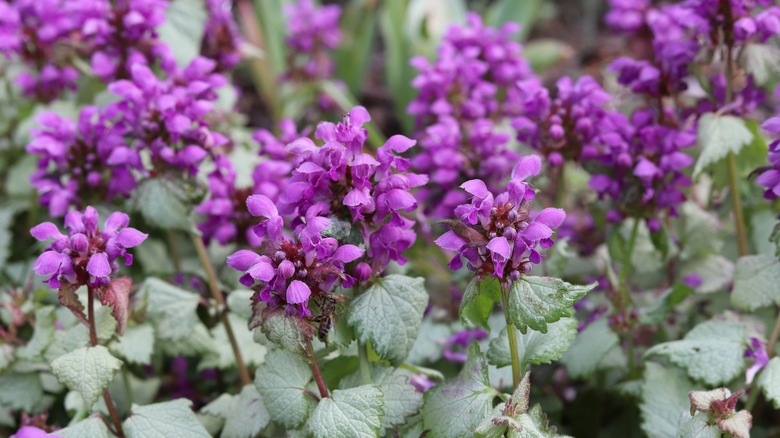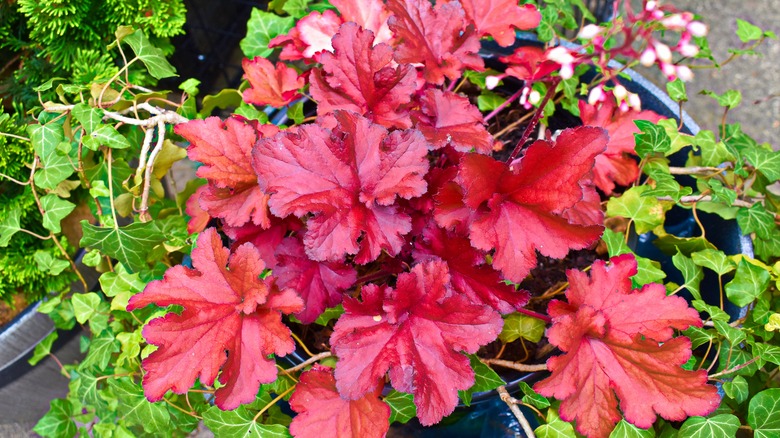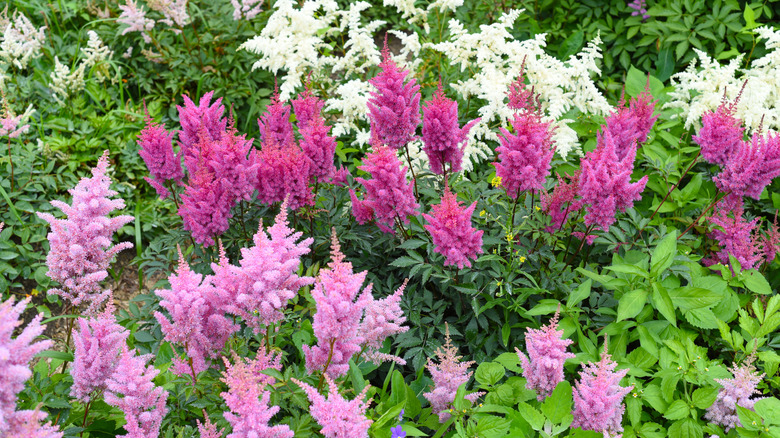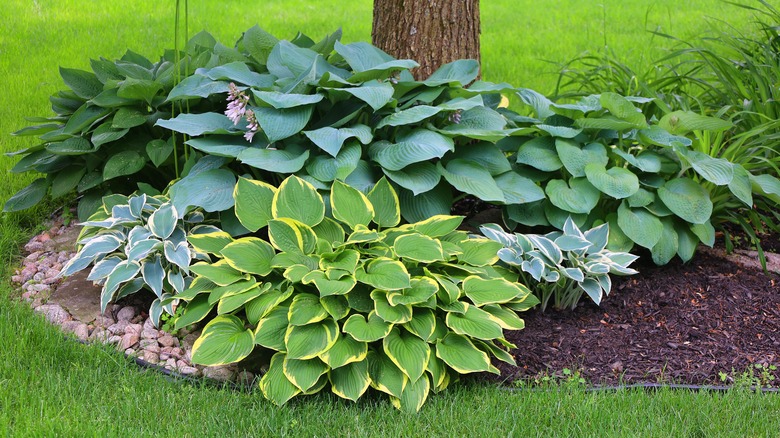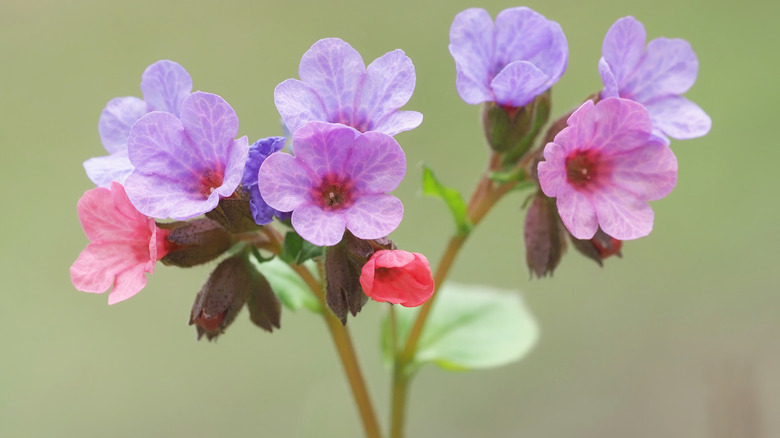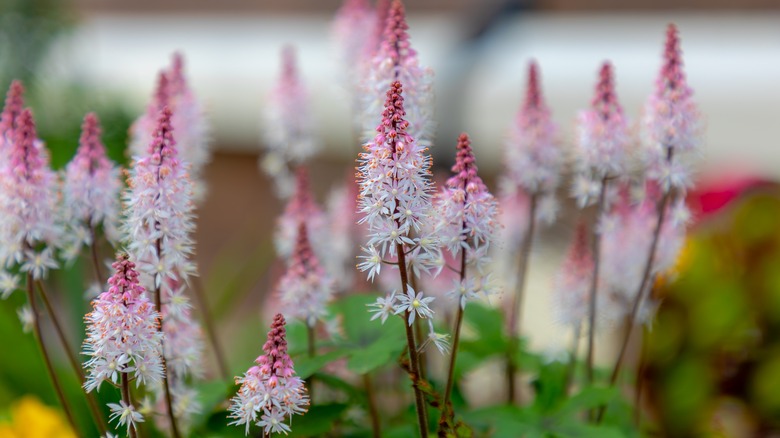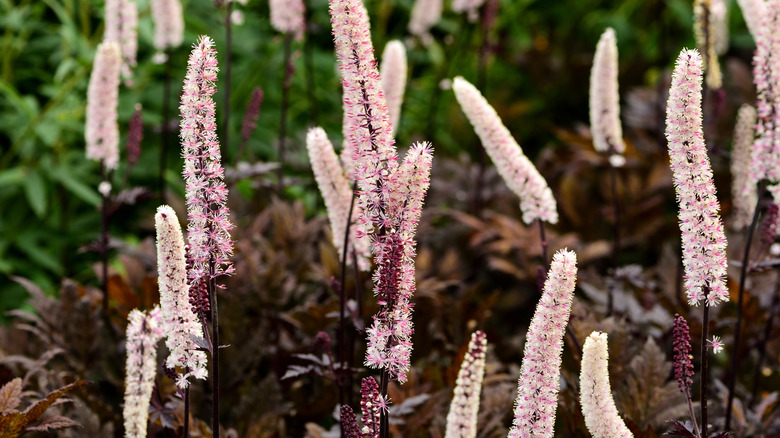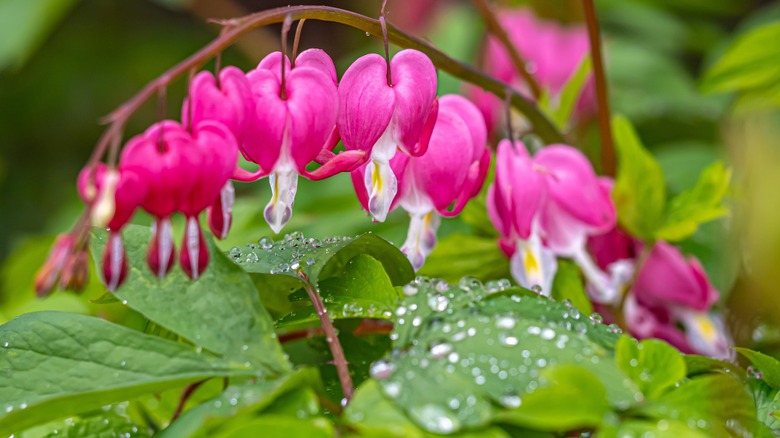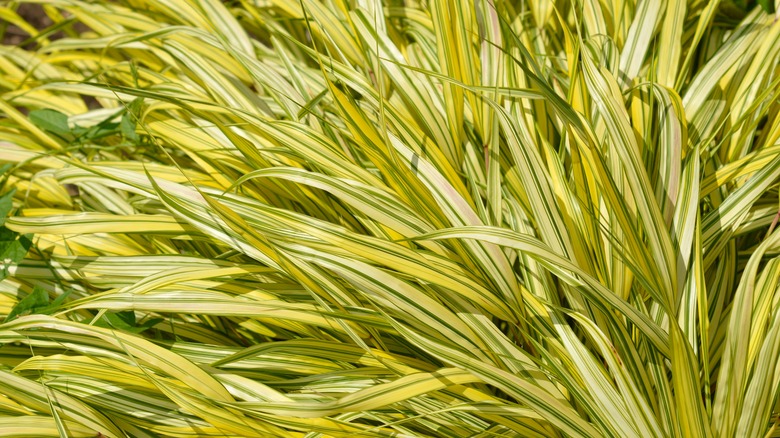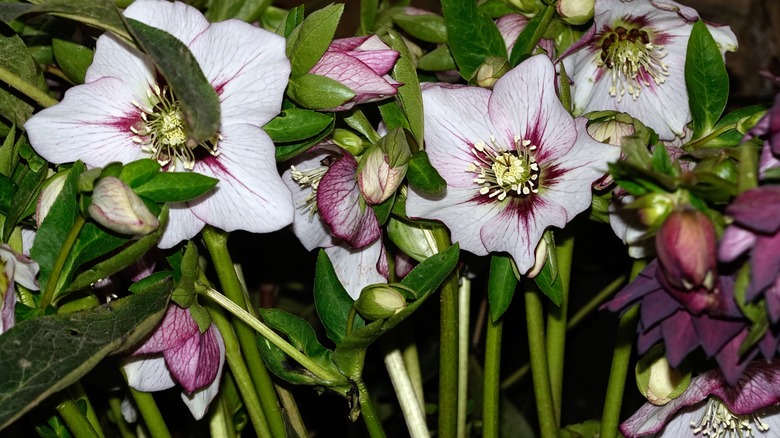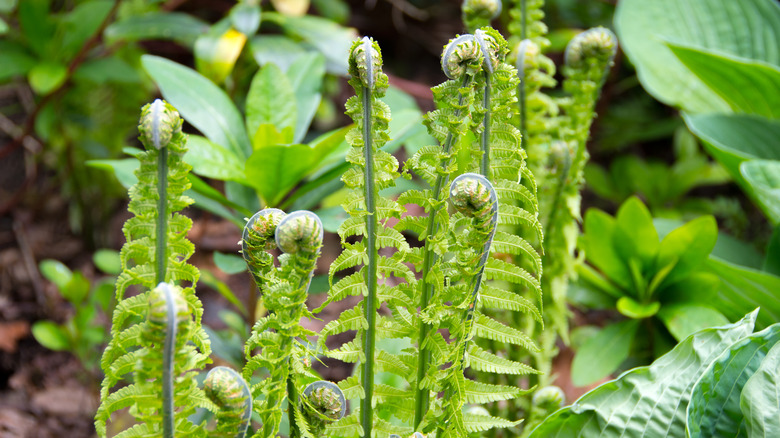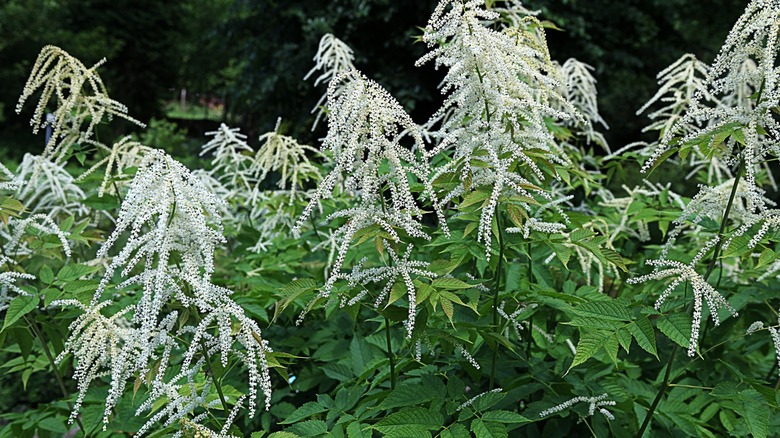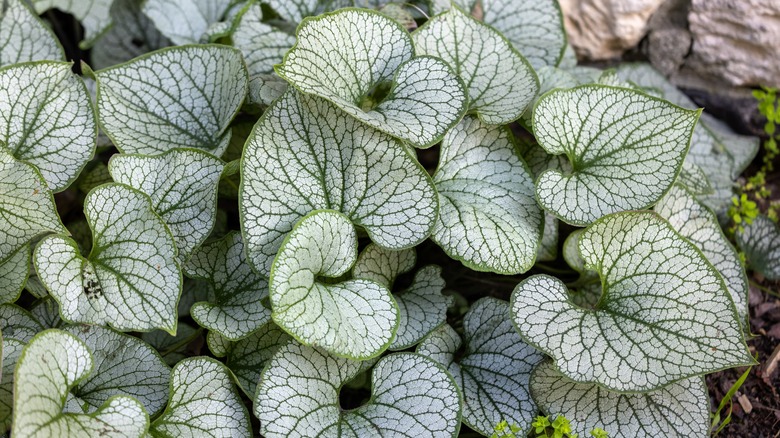12 Beautiful Companion Plants That Grow Well With 'Purple Dragon' Lamium
On the merits of its clouds of lavender petals attracting butterflies and bumblebees while cresting atop strikingly variegated silver-green foliage, 'Purple Dragon' lamium (Lamium maculatum 'Purple Dragon') has become the go-to fast-growing ground cover to turn yards into pollinator havens. Growing no higher than 8 inches, though spreading twice as wide, it's profusely planted in drifts in transitional areas, including north-facing sites, as the purple flowering ground cover thrives in sun and shade. When it isn't flanking pathways or border edges or serving as an effective understory for trees and shrubs, 'Purple Dragon' is plonked in patio containers and planters for year-round interest, at least in milder winters where its foliage retains its evergreen quality and resists herbivory.
But since, as plant and diversity aficionados, we can't resist packing the area to the moon with flowers, it's natural to hanker after other beautiful specimens that can team with lamiums to levitate the overall aesthetic. Fortunately, 'Purple Dragon' lamium's easy adaptability to most growth conditions makes it a breeze to match with diverse shade-loving companions, such as hostas, bleeding hearts, astilbe, ferns, forest grass, and coral bells for color and textural contrast. However, don't make the mistake of pairing them with shorter plants, as their vigorous spreading will outpace the low-growers, necessitating constant weeding of volunteers. With that said, read on to discover 'Purple Dragon' lamium's lovely companions.
1. Coral bells
Considering coral bells or alumroot (Heuchera spp.) encompass over 50 species with varying stripes, colors, forms, and growth requirements, find one optimum for your yard to mass alongside your 'Purple Dragon' lamium. Their coral or burgundy flowers, too, attract bees, hummingbirds, and butterflies all summer long. At the same time, the relatively dark-shaded, semi-to-full evergreen leaves lend color at other times in USDA zones 3 through 9. Keep them away from full sun in dry sites, or their leaves will burn. Remove the spent blooms to encourage multiple flushes right up to seasonal frost and separate the clumps every four years.
2. Astilbe
Astilbe (Astilbe spp.) or false spirea, the cotton candy-like flower that will add texture to your shady yard, also pairs well with 'Purple Dragon' lamium. When given moist, fine-draining, fertile soils (preferably enriched with compost), they bloom continuously through peak summer heat in varying shades of pink, purple, and white (depending on the cultivar). Their fine-leaved, bronze-tinted foliage contrasts beautifully against lamium's variegated silver. Skip deadheading astilbe because their snow-draped spent stalks persist through winter, enlivening the landscape. Club multiple cultivars of successive blooming times (such as 'Deutschland,' 'Bumalda,' 'Aphrodite') and heights ('Purple Candles,' 'Visions,' 'Pumila') to prolong seasonal interest.
3. Hosta
Hosta is a low-maintenance perennial to make your garden look fuller on a budget since it complements most plants, including 'Purple Dragon' lamium in dappled to shaded sites with its broad leaves. Besides, hostas keep weeds in check. Stick to small or medium-sized cultivars, such as 'Halcyon,' 'Twist of Lime,' or 'Kiwi Spearmint' if you wish to retain the groundcover concept. But if you want to create a height contrast, select larger types like 'Cathedral Windows' or 'Gold Standard' with lavender blooms. Work shed leaves or composted manure into their soils to ensure adequate drainage and fertility.
4. Lungwort
Lungwort (Pulmonaria spp.) is another silver-speckled ground cover that will add stunning flowers to a shady yard, attracting the attention of bees while augmenting the brightening effect of 'Purple Dragon' lamium's foliage at night. However, lungworts are a novelty because their buds open as pinks but age into violets and blues, thus presenting multiple shades simultaneously during the growth season. Give them morning sun and organically rich soils in growth zones 5 to 9, and watch the deer- and rabbit-resistant perennials kick in their flowering season in late winter. Trim the dead foliage to keep the plant vigorous.
5. Foamflower
If you've been growing 'Purple Dragon' lamium as an understory tree planting, complement it with the heart-shaped, glossy foliage of foamflower or false miterwort (Tiarella cordifolia). Certain cultivars like 'Running Tapestry' assume bronze undertones along the veins as the weather cools, adding fiery winter interest. These semievergreen (evergreen in the mild south) perennials thrive in dappled to heavy shade, enticing a bevy of bees, songbirds, and butterflies with their pink-tinged, creamy white flowers from spring to fall. Ensure their soils remain moist (not wet) but well-draining to encourage prolific blooming. Divide the clumps every couple of years.
6. Bugbane 'Hillside Black Beauty'
In a woodland setting, consider combining 'Purple Dragon' lamium with Bugbane 'Hillside Black Beauty' (Actaea simplex, formerly Cimicifuga ramosa). It will add height and color contrast to your garden through its 2½-foot tall green clump that eventually metamorphoses into purplish-black tones and grape-like fragrance. Late summer pollinator interest also becomes available through its pale pink flowers around which butterflies, hummingbirds, and bees gather for nectar. Although it tolerates heavy shade, the plant tends to bend towards a source of light, so plan its location carefully, or even better, plop it in any lightly shaded space.
7. Bleeding heart
Front run the intermix of 'Purple Dragon' lamium, hosta, and astilbe by supplementing them with bleeding hearts (Lamprocapnos spectabilis, previously Dicentra spectabilis). These spring perennials make a show of color with their pink heart-shaped flowers oozing out white petals, much to the delight of hummingbirds and butterflies. Consistent watering is key to keep the plant blooming into fall, or it will grow dormant in the solstice heat. Alkaline soils are favored, but bleeding hearts will make do with pH-neutral soils so long they are nutrient-rich and arrayed in the morning sunlight. They self-seed and self-sow without growing invasive.
8. Golden Hakonechloa
Golden Hakonechloa (Hakonechloa macra 'Aureola'), Hakone or Japanese forest grass' golden child (read "cultivar"), serves as a befitting duo to 'Purple Dragon' lamium in Asian-themed gardens. Based on the sun exposure, its sculpturally arching leaves exhibit golden halos (sun) or lime green-to-chartreuse hues (in shade), deterring deer browsing. Best of all, Hakone grasses add fall interest by donning burnished copper shades, though they'll die back in the winter chill, especially if they haven't been mulched. They're effectively low maintenance, mainly requiring cutback in early spring and division every couple of years before their volunteer runners naturalize themselves.
9. Hellebores
Known by several names, including Christmas roses and Lenten roses, hellebores (Helleborus sp.) should be your companion pick if you're looking to pick off from where 'Purple Dragon's' bloom season ends in the fall, extending the display through the winter. Its polished, dark green foliage juxtaposes beautifully against lamium's variegated form. Winter hardy through zone 5, hellebores perform their best in dappled-to-partial shade and loamy, alkaline soils. However, if you've got kids and pets, skip hellebores, as most of their plant parts are toxic and may even prompt skin irritation. Seeds may take two years to flower.
10. Ferns
Another way to create textural contrast for your 'Purple Dragon' lamium is to plant shade-loving ferns such as ostrich fern (Matteuccia struthiopteris) if your garden verges on bog or cinnamon fern (Osmundastrum cinnamomeum) if you've got acidic, humus-rich soils. You may pick any others native to your location and interplant them with hostas and astilbes. Plenty of songbirds, such as warblers, rely on ferns' fronds for winter cover, adding much-needed wildlife value. Most fern varieties resist pest pressure, including deer and rabbits. They're usually low maintenance and adapt well to moderate (sometimes deep) shade.
11. Goat's beard
Although goat's beard (Aruncus dioicus) is quite popular as a border backdrop in woodland or rain gardens because of its over 3-foot-tall frame, it can be trimmed down into a neat groundcover after it has spent all of its blooms. Prior to that, its mid-summer, creamy white inflorescence serves as an effective highlight for 'Purple Dragon' lamium's petals, drumming interest from butterflies and birds. Alternatively, directly plant compact cultivars like 'Glasnevin.' Regular irrigation is a must, or the growth will suffer. In the warmer climates of zones 3 to 7, it requires partial or dappled shade.
12. Siberian bugloss
In dry, shaded sites with immense deer and bunny pressure, Siberian bugloss or false forget-me-not (Brunnera macrophylla) can oblige as a worthy companion to 'Purple Dragon' lamium. Both plants support variegated, heart-shaped foliage, especially when you select cultivars like 'Jack Frost' and 'Silver Heart,' although bugloss stands a tad taller at over 1½ feet. It also brings in spring color through its blue rayed flowers that are well-liked by butterflies and bees. Despite being hardy in USDA zones 3 to 8, these perennials aren't recommended in the southeast region, as they prefer cooler temperatures during nighttime.
